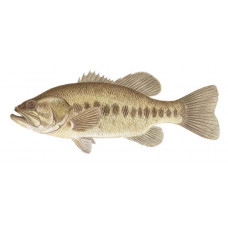Latin name
Micropterus salmoides
Other names
Black bass, largemouth, bigmouth, linesides, Oswego bass, green bass, green trout, Florida bass, Florida largemouth, southern largemouth, northern largemouth; French: achigan à grande bouche; German: forellenbarsch; Italian: persico trota; Japanese: okuchibasu; Portuguese: achiga.
Identification
Compared to other members of the sunfish family, the largemouth bass has an elongated and robust shape. He has a large mouth, with the end of his upper jaw dropping farther back than the back edge of his eye. The dorsal fin has a deep notch separating the barbed and soft rays. The tail is broad and slightly forked. The coloration varies greatly and depends on biological factors and habitat, the fish usually has a light green or brown hue of the back and upper flanks, white lower flanks and belly, and a broad band of diamond-shaped spots along the midline of the body. This stripe particularly distinguishes it from its close relative, the smallmouth bass, as does the upper jaw, which in the smallmouth bass does not extend beyond the eye. The largemouth does not have a serrated spot on its tongue, which helps distinguish it from the spotted bass.
Distribution
Largemouth bass is endemic only to North America, and its original range was the eastern half of the United States and southern Ontario and Quebec in Canada. Since the late 1800s, its range has expanded to include most or less all the United States except Alaska and most of the southern borders of Canada, as well as numerous countries in Europe, Asia, Africa, South America, Central America, and the Caribbean.
Habitat
Largemouth bass is usually described as a fish that lives in weedy areas of ponds and lakes. In fact, it adapts well to many habitats and many locations in various types of water bodies. These bass live in streams, ditches, glades, channels, and many small holes where suitable shelter and food is available. They mostly live in reservoirs, lakes, ponds, and medium to large rivers, and not always in weedy areas. They navigate shelters and find most of their food near them. Favorite habitats include logs, stumps, lilies, shrubs, thickets of weeds and grasses, bushes, docks, fences, standing timber, bridge pilings, rocky banks, boulders, edges of weed beds, creek beds, shoals, and islands. Although most bass live in coastal areas, some spend time away from shore, especially in lakes without vegetation. Largemouth bass are most active in water temperatures ranging from 65° to 85 °F. Temperatures below 70° are optimal. They do well in temperatures much higher and lower, including waters where temperatures reach 90 °F and frozen lakes where temperatures drop to mid-30°.
Size
Largemouth bass can live up to 15 years. Average lifespan varies; fish rarely live more than 10 years. Throughout the range, bass caught by anglers average 1-11⁄2 pounds (10-13 inches), but individuals up to 5 pounds have been caught, less frequently 7 to 10 pounds. The maximum size may be 25 pounds, but this has not been proven, and only about a dozen bass in the 20-pound class are known. The largest specimen is a world record 22 pounds, 4 ounces, caught in 1932 in Lake Montgomery, Georgia.
Life history and Behavior
The spawning of largemouth bass occurs from late winter to late spring. The timing of spawning depends on latitude and temperature. Southern populations spawn earliest, and the northernmost populations spawn latest. They begin spawning about the time the water temperature reaches 60 °F. The 10- to 12-inch fish are already old enough for first spawning. The male selects and prepares the nest site, a round bed usually 1 to 4 feet deep, often next to some object along the shoreline. The female is nudged by the male to the nest site, lays her eggs, and leaves. The male guards the eggs, which hatch after a few days, and then guards the fry for a short period of time. The growth rate of largemouth bass is extremely variable, influenced by geographic location (north vs. south), the specific body of water they inhabit in a particular region, and individual differences even within the same population. Despite these factors, largemouth bass are capable of growing rapidly under favorable circumstances.
Food and feeding habits
Adult perches feed mainly on other small species of fish, as well as crayfish. However, they are extremely opportunistic and can consume snakes, frogs, salamanders, mice and other creatures. As aggressive predators, they feed from ambush and can chase fish in open water. In normally warm water, digestion is fairly rapid, but in extreme heat or cold temperatures, digestion slows down, causing bass to feed less frequently. Perch are well known for their ability to find prey in murky water and at night. They feed mainly by sight, if the clarity of the water permits; at other times they use their highly developed lateral line to detect vibrations and find prey. Fish can also detect odors, but their sense of smell and taste are used less for feeding than sight and hearing.
Reproduction
No information
| Classification | |
| Phylum | Chordata |
| Class | Actinopterygii |
| Squad | Perciformes |
| Family | Centrarchidae |
| Genus | Micropterus |
| Species | M. salmoides |
| Features | |
| Conservation status | Least Concern |
| Habitat | Pelagic |
| Life span, years | 16 |
| Maximum body weight, kg | 11.4 |
| Maximum length, cm | 75 |
| Sailing speed, m/s | No information |
| Threat to people | Edible |
| Way of eating | Predator |
Bass, Largemouth
Tags: Bass, Largemouth


